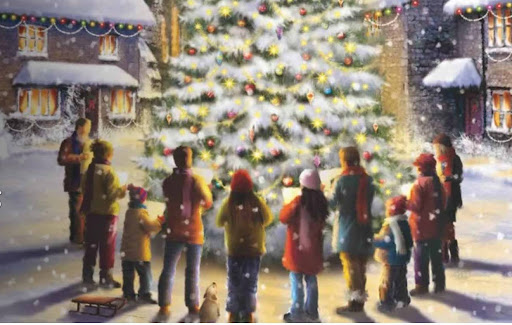by Mike Telin

This setting serves as the inspiration for Apollo’s Fire’s “Wassail! An Irish-Appalachian Christmas.” Written and designed by artistic director Jeannette Sorrell, this theatrical concert follows the journey of the Irish immigrants who crossed the Atlantic to America through carols, reels, and stories.
Led by Sorrell, the program features Irish singer Fiona Gillespie, vocalist Sam Kreindenweis, Kathie Stewart on wooden flutes, fiddlers Susanna Perry Gilmore, Emi Tanabe, and Caitlin Hedge, Tina Bergmann on hammered dulcimer, and Anna O’Connell on vocals and Celtic harp. Performances begin on Wednesday, December 6 at 7:30 at Bath Church UCC and run through December 17. Irish actress Derdriu Ring joins the company December 14-17. See our Concert Listings for times and locations. Tickets are available online.
Bergmann, who is a regular on Apollo’s Fire crossover programs, first met Sorrell nearly 30 years ago while the conductor was looking for a hammered dulcimer player for an early American program. “She went to the Kent State Folk Festival, which is sort of my home festival, and came to one of the workshops where a good handful of hammered dulcimer players were presenting,” Bergmann recalled during a telephone conversation. “She approached me afterward and I invited her to my apartment. She had me play for her, and that’s how it started. I think it was in 1994, so it’s been an incredible journey.”
Bergmann said that what she finds attractive about the music of “Wassail!” is how Irish music melded with regional American musical traditions. “I think it’s a lovely thing that an Irish piece came over and sort of changed into a Missouri fiddle tune or a Kentucky fiddle tune, but it’s absolutely related to the Irish piece that it came from.”

Bergmann (pictured) noted that in China the instrument is known as the yangqin, in Germany the Hackbrett, in Hungary the cimbalom, in Iran and Iraq the santur, and in Spain the salterio — and the list goes on.
Bergmann was first introduced to the instrument through her mother, who was recovering from a debilitating health crisis. “She had never played an instrument before, but one of the things that we did as a family once she was able to walk was to go to Hale Farm and Village where there was a big music festival. My mom saw a mountain dulcimer and told my dad, ‘Jim I want one,’ and he said, ‘Honey I’m sorry but I don’t have the checkbook.’ And she said, ‘Go home and get it.’ So he did, and she went home with a mountain dulcimer under her arm. She taught herself how to play, which was a big part of her healing.”
Although Bergmann knew she was not supposed to touch the instrument, one day she couldn’t resist temptation, and took it off the shelf, sat on the floor, and began to play. “I was eight years old, and when mom came downstairs and found me playing it, she said, ‘Well, we’re going to get one for you as well.’ So she did.”
Soon after, her brother began playing the harmonica, and her mother purchased a West Virginia single-bridged hammered dulcimer for her father, who also started building hammered dulcimers. “Until I was in my mid-forties, he built my instruments, which was incredible.”
Although Bergmann is primarily self-taught, she did receive her first lessons at a week-long camp at age 14. “It was a terrible fit. The teacher was excellent, but I think he didn’t know how to deal with a 14-year-old girl. I was probably the youngest person there by at least two decades. And musically I wasn’t in a place where I could have gotten what he was offering out of the workshop.”
Bergmann went on to Kent State University, earning a degree in music education. And while there, she found herself serving on the all-campus programming board. She also chaired the Kent Folk Festival, which she said was fun after having participated in it for many years. “I booked the hammered-dulcimer group No Strings Attached. And then I went to a week-long camp with two of their players. Because they had seen me in action, they really challenged me in all these fantastic ways. And that put me on a growth explosion for about ten years.”
In addition to performing at festivals and with Apollo’s Fire, teaching is also part of her musical life. She’s been a music specialist at Hershey Montessori in Concord Township for 23 years and currently has around 20 private students. “Some are local and come to me in person, but I have people from England, Germany, Canada — people from all over.”
Circling back to her 30 years with Apollo’s Fire, Bergmann said that being involved in the ensemble’s crossover programs has exposed her to music that she would not necessarily have had the opportunity to be immersed in. “One of my favorite series that we’ve done was the ‘Sephardic Journey’ program. Sephardic music is beautiful and there is a tradition with the hammered dulcimer. I’ve also listened to quite a bit of hammered dulcimer music of other cultures — I’ve learned different techniques and how to move differently on my instrument because the scales and the modes are so removed from what I’m used to. And I would like to dive into that and explore it more thoroughly.”
Bergmann is also toying with the idea of traveling to Spain or Italy to study the salterio. “Working with a teacher and really developing some chops would be great because the ornaments, the manner, and the articulations are different. So learning how to play Baroque music on the salterio would be a beautiful little pivot into another culture’s dulcimer that I think would be fascinating. And my husband and I are somewhat recent empty nesters, and travel is always a good thing.”
Published on ClevelandClassical.com December 5, 2023.
Click here for a printable copy of this article



